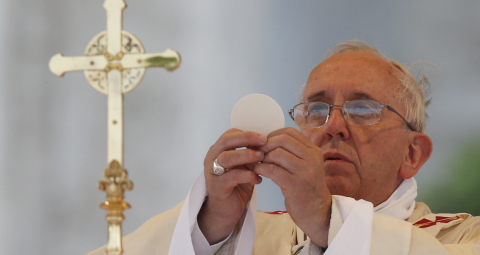December 6 | ![]() 0 COMMENTS
0 COMMENTS ![]() print
print

Split opinions on the body of the Church
Division over teaching on the Eucharist has a long history which continues to this day, writes Colette Cooper.
Many issues appear to divide opinion within the Church today, and perhaps one of the biggest is how Catholics perceive the Eucharist.
A Pew survey in the US found that around 50 per cent of American Catholics believed that the bread and wine become the Body and Blood of Christ during the Holy Sacrament while the other half believe this is symbolic.
This division is both large and startling. How has the Church reached the stage where half of US Catholics do not believe in one of its basic tenets: the real presence of God when they receive Holy Communion?
Meaning
Surely, if we can be flexible about the meaning of the Eucharist, we are ignoring what the Catechism teaches, giving ‘believers’ the leeway to alter the rules as they go along?
The Catechism of the Catholic Church teaches that the Eucharistic rite transforms the bread and wine into Christ’s Body and Blood, and that Christ becomes present through the Sacrament.
This ‘transubstantiation’, the transformation of bread and wine, was explained by St Ambrose thus: “Be convinced that… the power of the blessing prevails over that of nature, because by the blessing nature itself is changed… Could not Christ’s word, which can make from nothing what did not exist, change existing things into what they were not before? It is no less a feat to give things their original nature than to change their nature.”
Nonetheless, there has rarely been agreement, and disputes have also led to schism and the advancement of reformed and Protestant theologies, many of which reject this doctrine.
Disagreement
An example of disagreement on this issue between Catholics involves the writer Flannery O’Connor and author Mary McCarthy.
In a letter collected in her book, The Habit of Being, O’Connor gives an account of a literary gathering she attended in New York. She said that she had hardly said a word all evening, until Mary McCarthy pontificated on the subject of the Eucharist.
O’Connor said: “Well, toward morning the conversation turned on the Eucharist, which I, being the Catholic, was obviously supposed to defend. [Mary McCarthy] said when she was a child and received the Host, she thought of it as the Holy Ghost, He being the ‘most portable’ person of the Trinity; now she thought of it as a symbol and implied that it was a pretty good one.
“I then said, in a very shaky voice, ‘Well, if it’s a symbol, to hell with it.’ That was all the defence I was capable of, but I realise now that this is all I will ever be able to say about it, outside of a story, except that it is the centre of existence for me; all the rest of life is expendable.”
Existence
O’Connor’s view is consonant with the Church’s teachings: ‘the rest of life’ will come to an end, but God remains, ‘the centre of existence.’ For believers, God’s existence is central to our Faith, and is affirmed through His presence at Mass in the Eucharist.
It is, therefore, surprising that so many US Catholics now seem to agree with McCarthy’s opinion (which was given in the immediate post-war era) rather than the devout O’Connor.
Within the Church, the doctrine of transubstantiation was defined at the Fourth Lateran Council in 1215, and confirmed at the Council of Trent (1545-63) in its Decree on the Most Holy Eucharist.
The Council declared: “In the Blessed Sacrament of the Holy Eucharist, after the consecration of the bread and wine, our Lord Jesus Christ, true God and man, is truly, really, and substantially contained under the appearances of those perceptible realities.”
Reformation
This definition was said to be a response to dissent within the Church and the Protestant reformation.
There are perhaps many different factors at play as to why a symbolic belief of the Eucharist has come about. The point remains, however, that if some Catholics feel this way, prayer itself is called into question: what are they praying to? What is the point of going to Mass? Why do we need to receive communion if it is merely a symbol?
Once this ‘symbolism’ is accepted, what then is Benediction and the Adoration of the Eucharist about, if not being permitted the good fortune to be in God’s presence, before us on the altar.
On a personal note, there is a real sense of peace and comfort from attending Benediction and Adoration, and this is only magnified during Mass, when we gather in Faith. There is great reassurance in the words of The Last Supper which form the centre of the Eucharistic rite: “While they were eating, Jesus took bread, gave thanks and broke it, and gave it to his disciples, saying, ‘Take and eat; this is my body.’’
Miracles
God’s living presence is also attested by the many miracles associated with the Eucharist over the years. For instance, at the parish of St Mary in Buenos Aires, the host reportedly began bleeding when consecrated and part of it became human tissue. After many intense studies, it was found that the tissue was part of a heart, a muscle of the myocardium.
There have been many similar accounts around the world, The reality of Christ’s sacrifice is central to Mass, and the Eucharist represents His last meal, communion, with his disciples before his Passion and death on the Cross. It is for this reason that Christ’s own words are repeated in the Sacrament, a report of a real, not a symbolic, event.
“And he took bread, gave thanks and broke it, and gave it to them, saying, ‘This is my body given for you; do this in remembrance of me.”’










